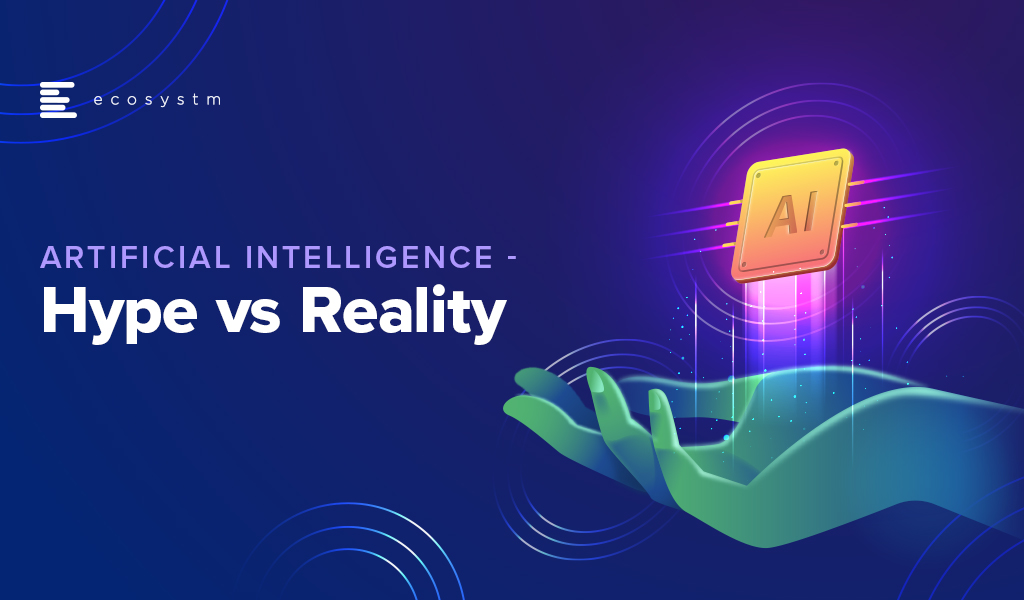
Artificial Intelligence (AI), machine learning and deep learning are buzz words that have organisations – especially the C-Suite – excited about future possibilities of what technology can do for their business. However, these are not merely buzz words and are actually being leveraged by early adopters. At the same time, there are organisations that are keen to adopt the technologies but are unsure of the benefits and the associated challenges act as a barrier to adoption. So, is AI over-hyped or is it a reality for enterprises today? Ecosystm research provides some answers.
The Buzz Around Artificial Intelligence
There are several factors that contribute to the curiosity around AI and why several organisations are evaluating the adoption of AI:
Promotion by large tech vendors
The world’s leading technology providers are in a race to incorporate innovations (mostly driven by AI) within their product and service offerings. Heavy investments in R&D and new patents are aimed at increased market share, as the top tech vendors continue to compete to consolidate and grow their global presence. The perception is that AI-related patents are directly proportional to future market potential. It is not uncommon for the providers to promote these future capabilities – long before they hit the market – as part of their go-to-market messaging. There has been a surge in the number of AI patent filings in recent years with Microsoft leading with more than 18,300 patents followed by IBM (more than 15,000) and Samsung (more than 11,000). As these tech giants keep investing in R&D, apply for newer patents and publicise them, it creates a positive buzz in the market.
Consumerisation of AI
Just like any emerging technology, AI is still, to some extent, an enigma. However, the consumer market gets constant glimpses of how AI can have a positive impact on people’s lifestyle. Amazon, Samsung, Microsoft, Apple – to name a few – have all introduced smart AI solutions to their consumer products. From smart voice assistants that help us with our voice searches to controlling homes with digital assistants, users have been impressed with their early interactions with AI. Many think that the same way as AI has percolated into their personal lives, it will one day be pervasive in enterprises as well. The requirements of an enterprise AI solution is completely different and complex. For example, wearables and wellness mobile apps can help you take control of your health, but for them to become part of the healthcare system, they require FDA approval, a well-documented workflow and policy implementations. But, wearables get people curious and create a buzz about the role of AI in healthcare.
Government initiatives
Several governments are engaging and getting serious about AI and are investing in AI R&D. Many have created an AI roadmap including governance, to promote the adoption of AI. AI.gov was launched by the US Government to centralise AI efforts, share knowledge on AI and drive adoption across government agencies and departments. Some departments have already adopted AI. The US National Oceanic and Atmospheric Administration (NOAA) has been using AI to improve their forecasts. This helps in better prediction of high-impact weather events. Smart city applications are also seeing increased adoption of AI, including in citizen engagement. Cities and government departments are investing in AI-based call centres to answer repeated or routine queries. For example, the United States Army uses an interactive virtual assistant to check qualifications and answer questions with more accuracy. When governments back a technology area, it creates an interest in the citizens.
Success stories
Every day we read about some AI implementation that has positively impacted an organisation or its customers. Twitter’s use of AI-driven text and image analytics to detect hate speeches and terrorist activities has been well-publicised. Gaming companies are actively using AI to improve user experience through Mixed Reality and AI technologies. The recent coronavirus outbreak was first detected by BlueDot, a Canadian company using AI technologies. Such success stories encourage other enterprises to evaluate the technology.
Beyond the Buzz
While we are adopting AI/automation as part of our consumer goods (such as phones, smart home systems) and services (such as search engines, online maps) the enterprise adoption of AI does not really match up to the hype around it.
Ecosystm research shows us what the popular AI solutions are and what their current adoption is globally, as well as what it is likely to be at the end of the year (Figure 1). While some solutions have become popular, especially in industries such as Manufacturing, Mining & Resources and Construction, the reality is that we have not yet reached mass adoption. Of the organisations that are planning to implement some AI solutions, 44% consider the investment as strategic to their organisational goal. The rest are mostly looking at ad-hoc implementations to test the waters.
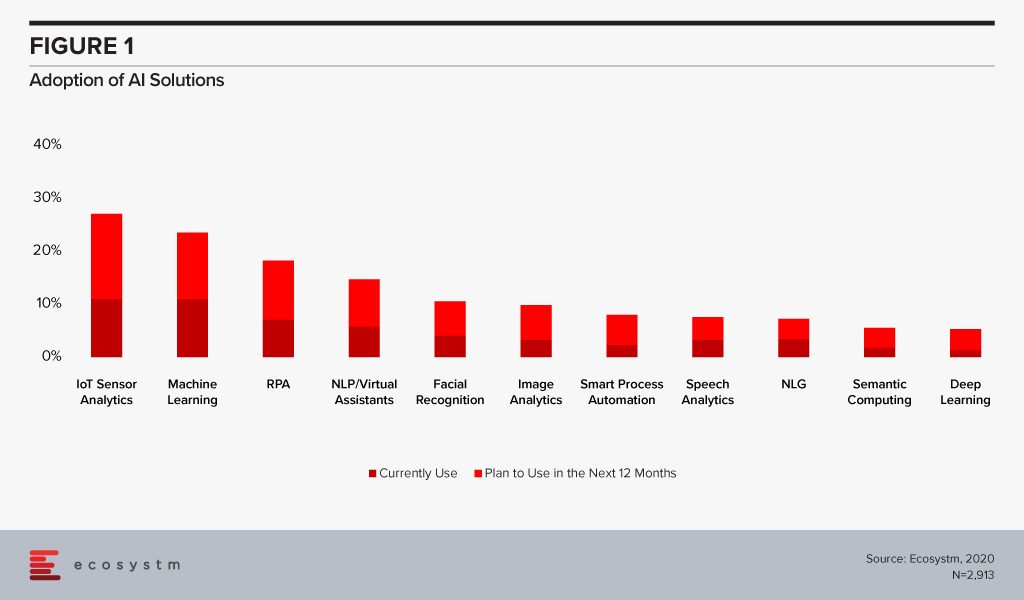
What is hampering more widespread adoption of AI? For both organisations that have embarked on their AI journeys and those who plan to in 2020, the challenges are the same (Figure 2).
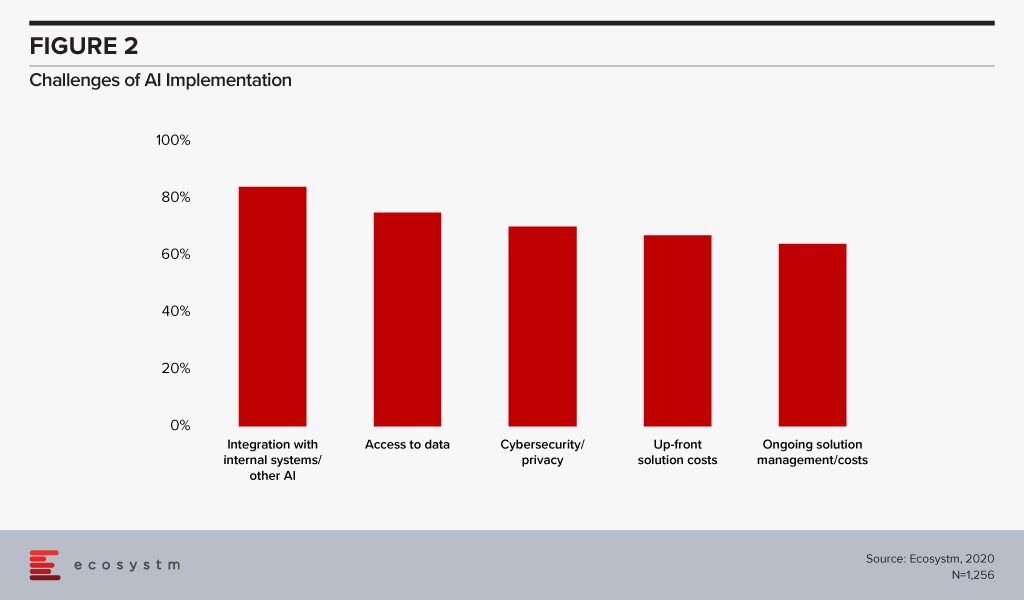
AI integration is a complex process. The more organisations want to integrate AI investments into their transformation journey, the more complicated the integration becomes. There needs to be an identification of the expected outcomes, mapping of the data that will be required to help the algorithms, real-time or near real-time data sources and consistency in data infrastructure and sources. Organisations have legacy systems that run in siloes. Integration requires a clear roadmap and dedicated resources, often a third party.
Even in industries that have access to huge organisational data repositories, data access can be a challenge, for technological or compliance reasons. AI requires a huge amount of data to train and run algorithms. Data scientists are often challenged with access to quality training data at the scale required to train the AI systems.
Cybersecurity concerns are natural for any emerging technology area. AI systems have access to enormous organisational data. With threats ranging from ransomware, data breaches to hackers tampering with physical and industrial systems, it is dangerous if AI system falls in the hands of cybercriminals. Instances such as when criminals used an AI-based software to impersonate the voice of a company CEO to commit a €220,000 fraud, also add to the concerns around cybersecurity and AI.
Another reason why organisations find deploying AI solutions difficult is that they do not involve the right organisational stakeholders in the AI decision-making process (Figure 3). While IT is likely to know where the data resides and have a better understanding of the systems implemented, the true success of AI deployments will be measured in user acceptance. An AI solution will obviously impact the existent workflows in an organisation, and if the stakeholders are not convinced, or are unsure of the benefits, it will be difficult for AI to have an organisation-wide impact.
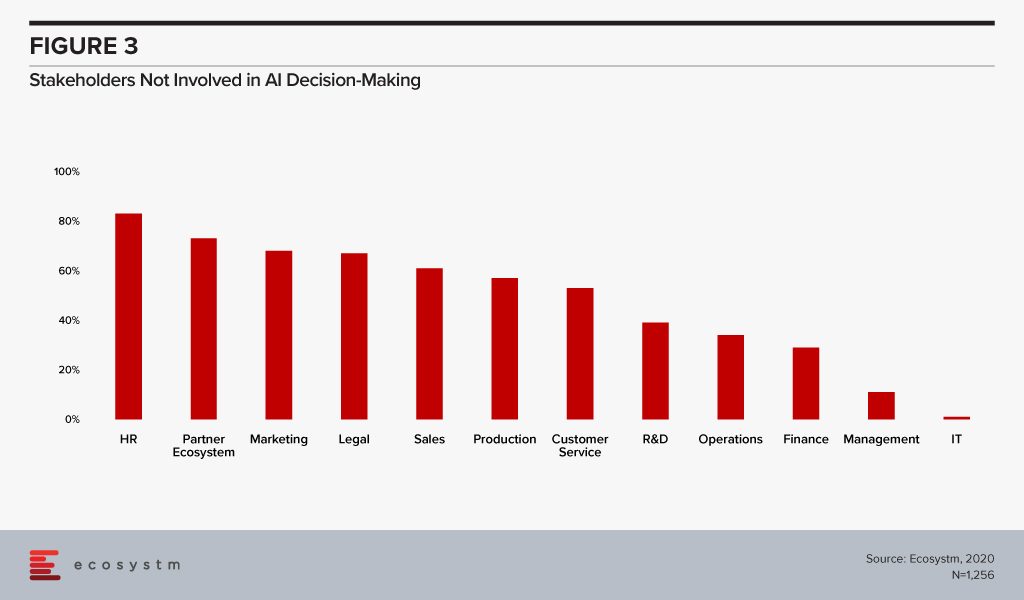
Moreover, internal IT may not have the right skills to implement and maintain an AI solution. It will become important for organisations to involve strategic partners who can guide the implementations, at least in the initial stages. While 51% of organisations that have an AI solution engage an external strategic partner, only 33% of organisations that are planning to adopt AI have planned for a strategic partner to guide them. A strategic partner – with the right technical expertise and business experience – can help combat some of the challenges around integration issues and provide guidance on cybersecurity best practices.
AI clearly has immense possibilities and indeed is a revolutionary technology that will bring value to almost all industries. What is required for a successful AI implementation however is a roadmap – including a cross-departmental Centre of Excellence (CoE), a clear timeframe and KPIs to measure both business and technological success of the AI models. Unless organisations can plan their AI investments, the technology will not translate from hype to reality.





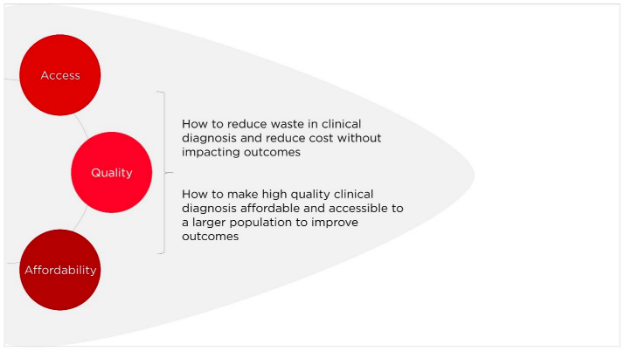


Great content! Super high-quality! Keep it up! 🙂